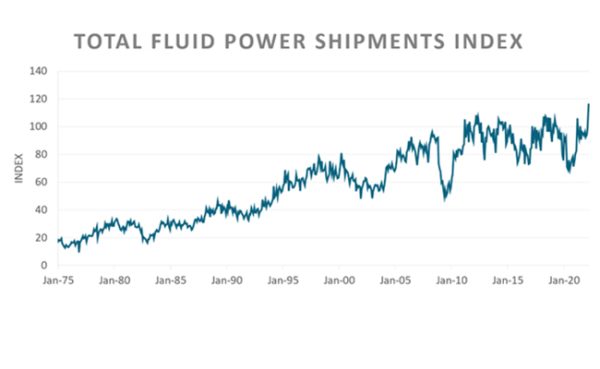Fluid Power’s Role in Our Nation’s Energy-Efficient Future
Part 6: Detecting and Correcting Inefficiencies in Hydraulic Systems
 By Eric Lanke, CEO, NFPA
By Eric Lanke, CEO, NFPA
This is the sixth in a series of articles describing NFPA’s actions focused on the development of a program within the U.S. Department of Energy (DOE) that can fund and focus on energy-efficiency improvements using fluid power technology. The envisioned program would be partly research-focused, helping to develop new energy-efficient fluid power technologies, and partly education-focused, helping to improve the design and maintenance of existing fluid power systems with current technologies and techniques. To read the full series, go to www.nfpa.com.
If you’ve been following this series, you know that we have been successful in establishing that fluid power research and education represent significant opportunities to reduce the amount of energy consumed in the United States, especially in the industrial sector. Several interactions with what is now the Advanced Manufacturing Office (AMO) of the U.S. Department of Energy have resulted in two areas of possible cooperation—getting fluid power engaged on the U.S. Council of Competitiveness, where future structures and private/public partnerships were being discussed to address energy efficiency, and seeing if fluid power could be better incorporated into the AMO’s existing industrial energy-assessment programs.
Last time, I talked about our interactions with the leaders of one of those energy-assessment programs—the Industrial Assessment Center (IAC) Program, where teams located at 24 universities around the country conduct no-cost energy assessments for small and medium-sized manufacturers. We were asked to provide them with information on how to detect and correct inefficiencies in existing fluid power systems and, working with the two content experts we had recruited with the help of our sister association, the International Fluid Power Society, we have begun to develop exactly that.
Our hydraulic expert, for example, has since produced a white paper on the subject, which suggests that assessors look for the following potential indicators of hydraulic system inefficiency:
- A large heat exchanger: One advantage of a hydraulic system is that the fluid has the ability to carry away the heat generated by mechanical inefficiency to a central location where it can be dissipated. A large heat exchanger indicates that a large amount of heat needs to be removed. However, a large heat exchanger is not a litmus test for efficiency. There may be explanations for the heat exchanger that do not include inefficiency. The reservoir may be sitting in the hot sun or snuggled up to another heat source. The heat exchanger may be oversized because it was readily available and is not being used to its capacity. A large heat exchanger is an indicator, but will require more research.
- The temperature of the fluid: The temperature of the fluid in the reservoir can be an indicator, certainly if it is above 45° C. However, the reservoir temperature can be deceiving. If it is a nice cool 35°C, it may only indicate an efficient heat exchanger. The fluid may be traveling across relief valves, through restrictive flow controls, and undersized conductors just before it passes through the heat exchanger. So, hot fluid is certainly a problem, but cool fluid may result from a cover up.
- Dark Fluid: Another indicator would be dark fluid. This is likely fluid that has been oxidized due to high temperature and water contamination. If the fluid is dark, even if the reservoir is cool, you need to hunt down the heat source in the circuit. Knowledge of component symbols is important here. It may allow you to determine the heat-generating culprits while looking at the circuit diagram. If you are not comfortable with your circuit-reading ability or if the culprit is elusive, a heat gun is a handy tool for finding the hot spots. The source could turn out to be an inefficient pump, motor, or leaking cylinder, which would not be obvious in the circuit diagram.

These and eight more indicators are described in the white paper, as well as steps that can be taken to correct the inefficiencies. A full copy of the white paper can be obtained by contacting NFPA. Similar information is also being developed for pneumatic systems.
The hydraulic document has already been forwarded to our contacts in the AMO, with the hope that we can re-engage on the question of how this information can be best brought into their assessment programs. When one considers that roughly 3% of all the energy consumed in the United States is consumed by a fluid power system—and almost half of that in the industrial setting—finding ways to improve the efficiency of these existing systems should become a compelling priority.
Next time, I’ll loop back and talk about the other opportunity that came out of our discussion with the AMO—getting fluid power engaged on the U.S. Council of Competitiveness, where future structures and private/public partnerships are being discussed to address the commercialization of new energy-efficient technologies.
The intent of this series is to keep NFPA members better informed about our efforts in this regard and also to seek their help in advocating for the envisioned program. Please watch this space for more background on this issue, as well as regular updates on our progress. If you would like to become more involved, please contact Eric Lanke directly at (414) 778-3351 or elanke@nfpa.com. Getting industry leaders engaged in this effort will be critical to its ultimate success.






